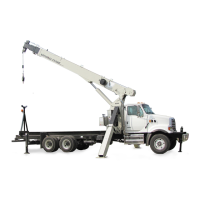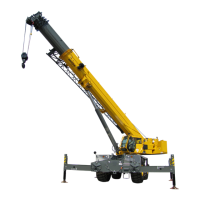National Crane Published 5-27-2018 Control # 039-06 10-5
800D CRANE INSTALLATION
PIN BEARING INSPECTION AND INSTALLATION PROCEDURE
Pin Inspection
1. Remove the protective covering from pins and inspect
each pin for nicks, gouges or deep wide scratches. A
small nick or gouge up to 1/8 in (3 mm) diameter can be
repaired by dressing the edges of the imperfection with a
file so that no metal protrudes above the circular surface
of the pin.
2. A circular scratch of up to 1/16 in (1.5 mm) wide or deep
can be repaired as in 1 above.
3. A lengthwise scratch on the pin of up to 1/32 in (0.8 mm)
wide or deep can be repaired as in 1 above.
4. Pins with defects larger than those listed in 1, 2 or 3
should be replaced.
Bearing Inspection
1. The bearings furnished with this machine are made up
of a tough epoxy impregnated wound glass backing
shell with a thin inner layer of filament wound bearing
material. The outer bearing material should be visually
checked for imperfections. Bearings with cracks or
gouges larger than 1/4 in (6 mm) diameter on the
outside diameter should be replaced.
2. Inspect the inner diameter surface of the bearing. any
scratches, cut or gouges which have penetrated through
the inner liner may cause premature failure of the
bearing. The bearing should be replaced.
Trunnion Inspection
1. The trunnion bore should either have a machined step or
have a spring spacer installed to prevent inward
movement of the bearing. If equipped with a spring
spacer, check to make sure the opening is positioned
over the grease hole.
Installation
1. Two bearings are to be installed in the boom pivot
trunnion located directly below the hoist and the
remaining four bearings are to be installed in the lift
cylinder, two at each side of the rod end of the cylinder
and two at each side of the butt end of the cylinder.
2. The bearings should be started in their respective bores
by rotating the bearing while applying inward pressure
with the hand. Once the bearing has been started
squarely into its bore, it can be driven to its full
counterbored depth by tapping lightly with a rubber
mallet. The head diameter of the mallet should exceed
the outside diameter of the bearing to ensure that the
bearing is not damaged during assembly into the bore.
3. If the bearing appears to be loose in the bore (if it can be
pushed in with hand pressure alone), it is permissible to
tighten the bearing by center punching the bore
diameter in approximately 50 places around and
throughout the 2 in (51 mm) deep bored area. Center
punching will raise the metal around the edge of the
punch mark and this raised metal will hold the bearing
firmly in place during machine operation.
4. After all bearings have been installed and before
attempting to assemble the machine, insert the pins
through both bearings in each end of the lift cylinder and
through the boom pivot bearings to insure alignment and
fit are correct. Also check the two sets of pin holes in the
turret and the pin holes in the boom ears to ensure that
the pins will slide freely through the leading hole and
start in the opposite hole. If a pin starts to bind through
the leading hole, do not force the pin any further to avoid
damaging the pin surface finish. Remove the pin and
clean any corrosion of burrs out of the holes with a round
file or emery cloth.
5. When pinning the boom to the turret, and the lift cylinder
to the turret and boom, use a round smooth bar of
approximately 1-1/2 in (38 mm) diameter as a pry bar to
align the pin holes. A pry bar with a sharp edge, such as
a crowbar, can gouge or cut bearing and this may lead to
premature bearing failure.
Fo
r
Reference
Only

